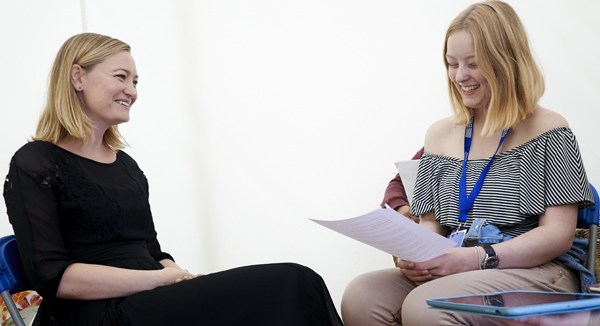This resource is great for:
Inspiration and activities on writing for a YA audience.
Summary:
An interview with creator of the Geek Girl series, Holly Smale, and some short writing activities and tips to help you write your own YA fiction.
Download this resource:
Getting Geeky with Holly Smale – PDF
Getting Geeky with Holly Smale – Word doc
Introduction:
Holly Smale is author of the bestselling Geek Girl series. She was spotted by a top London modelling agency at the age of 15 and spent the following 2 years falling over on catwalks, going bright red and breaking things she couldn’t afford to replace. By the time Holly had graduated from Bristol University with a BA in English Literature and an MA in Shakespeare, she had given up modelling and set herself on the path to becoming a writer.
Geek Girl was the no. 1 bestselling Young Adult fiction title in the UK in 2013. It was shortlisted for several major awards including the Roald Dahl Funny Prize and the Branford Boase award, nominated for the Queen of Teen award and won a Waterstones Children’s Book Prize and Leeds Book Award. There are now 13 books in the Geek Girl series.
During the 2017 Edinburgh International Book Festival, our young reporter Abbie took the chance to interview Holly and find out about her writing process and her top tips for aspiring YA writers. Read the interview and then get writing yourself using our short writing tips.
Activities – Writing YA Fiction: Getting Started
Part One
“[Modelling] was the catalyst that flung Harriet into a world that she didn’t understand, which is the essence of any good adventure story. You take a character and you push them out of their comfort zone, and that essentially is what the story is. So for me modelling was the catalyst that challenged Harriet. But it was never going to be a book about modelling, it was always going to be about what it was like being a teenager.”
Write a character study for a YA character who you’d like to read about. They could be similar to you – or completely different! What’s their name, age? What do they look like? What are their strengths and weaknesses? Who are their friends? What do they like doing? What do they aspire to be?
Then, think of a situation which would take your character completely out of their comfort zone. How would they react? Would they flounder, or would it make them stronger? Maybe they need the support of other characters to survive. Expand this scenario into a short story.
Part Two
“… you don’t really get a feel for somewhere until you’ve been there. You don’t know how it smells, you don’t know how it sounds, you don’t know what the lights are like. You can’t notice details through just watching a YouTube video. And so for me, I’ve been everywhere and that’s important to me. And it was a great joy to be able to write a series where a contemporary teenage character gets to travel. Because you know, the world is so fascinating. And although it’s great to be able to read books about worlds that don’t exist, it’s also really great to celebrate and kind of just elaborate on how exciting the real world is, and how it’s there for anybody to experience and to venture.”
Think of a place you’ve been which you remember vividly, or which had a big impact on you.
Close your eyes and try to remember how it felt to be there. Think about what you could smell, feel and taste, as well as what you could see and how it made you feel.
Think about who you might meet there, or who would be there. What are they doing? Are they on holiday, working or studying? How do they react to the place around them? Are they comfortable or are there problems in their life?
Write a short piece about a character in your chosen setting. Try to really evoke the place, but to also include how that character feels and how they relate to the setting.
Is your writing a standalone piece – or do you want to expand it into a story? Your story could tell the reader how the character came to be in that place, or what happens to them there.
Part Three
“…Geek Girl is inspired loosely by autobiographical things that happened to me as a teenager. So a lot of people think that, you know, I’m writing what I know. But in reality 90% of Geek Girl is fiction. And I think it’s really important to storytellers that we aren’t limited by telling our own story… I don’t feel like I should have to write stories that have all happened.”
Holly explains that Geek Girl is a mixture of inspiration from her real life but with a lot of fiction added in. Let’s play around with this structure as a quick way to start writing fiction.
Write a short paragraph (50-100 words) that could form the outline, or the start of a story. Use one piece of autobiographical fact, from your own life, then add two pieces of fiction, which you make up.
Do the same again, but using two facts, and just one piece of fiction.
Do you think it’s easy to tell what is fact and what is fiction? Does the fiction make the fact more exciting? Could this be the start of a story?
Further information:
Young reporter Abbie is taking part in What’s Your Story?, Scottish Book Trust’s development programme for teenage writers and illustrators. Find out more about the programme at www.thestoryis.co.uk
Watch this space! More author interviews, videos and resources from Edinburgh International Book Festival 2017 will be posted on the Learning Site over the coming weeks and months.
